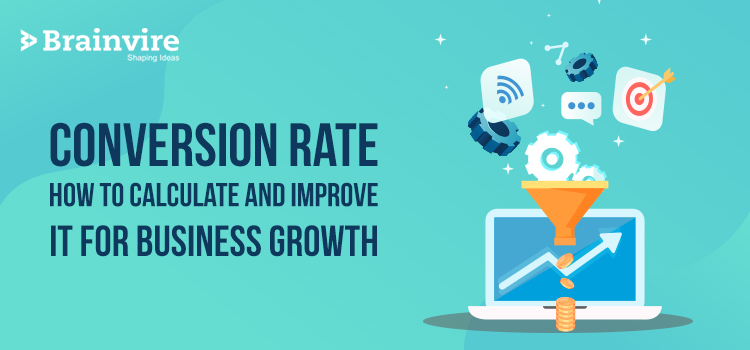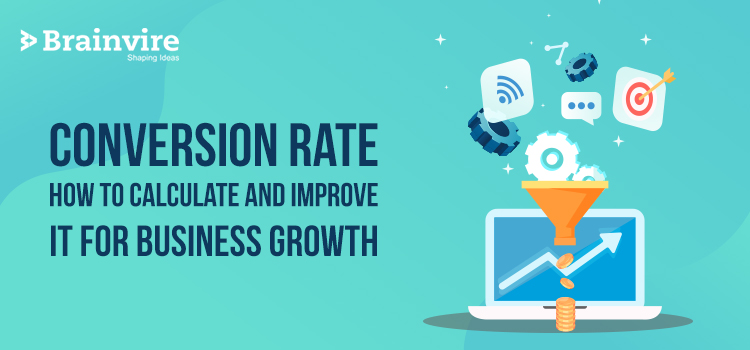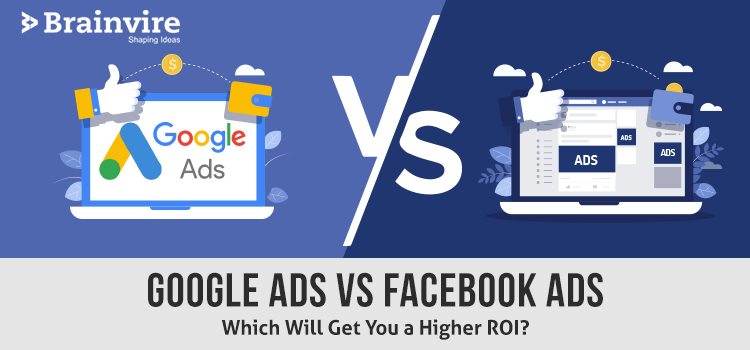
Conversion rate. Do you ever wonder what this term means or what is its significance in SEO marketing? Well, you are not the only one who thinks so. When I started out as a digital marketer, many aspects of this metric were unclear to me initially.
For a layman, conversion rate explains how good your marketing is at convincing people to do what you want them to do. This is what we call “converting” in the marketing community.
Once you have read this article completely, you will clearly understand what your conversion rate is, how to calculate it and most importantly, how to improve it.
Let’s begin.
What is Conversion Rate?
Your conversion rate is the percentage of visitors to your website or landing page that convert i.e. take the desired action. Now, the conversion is not always about making sales. Depending on your business goals, it could be almost anything. Take a look at some of the few common types of conversions:
- Submitting a form (contact us form, lead gen form, etc)
- Calling your business
- Engaging with your online chat
- Making a purchase
- Signing up for a subscription (either paid or free—like a newsletter)
- Registering on the site
- Downloading something (software trial, eBook, mobile app, etc)
- Engaging with your site in some way (time on site, repeat visits, number of pages visited)
The list can go on and on. These examples might have cleared your concept of conversion. Technically, these actions should be measurable and are collectively known as ‘conversion rate.’
But, how is it calculated? That’s what I will tell you next.
How can you calculate the conversion rate?
Conversions calculations are way too simple. Just take a look at the following formula taken from The Online Advertising Guide.
So you are dividing the number of conversions you get in a given time frame by the total number of people who visit your site or landing page and multiplying it by 100%.
Let’s say that your conversion is email subscriptions. So this is how you calculate it.
Sounds easy, right?
One of the great things about conversion rate is that you can be as specific or as broad with your conversion rate as you want to be. Let’s enlist a few different types of conversion rate you can use and how they help you examine performance:
- Overall conversion rate: How well does your website convert traffic from any source?
- Marketing channel conversion rate: Which is more likely to convert: AdWords traffic or Facebook Ads traffic?
- Page-level conversion rate: Which of your landing pages is better at converting traffic?
- Campaign conversion rate: Did my targeting changes improve anything?
- Individual ad conversion rate: Do I need to change my ad copy? Does this ad drive more qualified traffic?
- Keyword conversion rate: Which keywords deserve more budget?
Obviously, this list is just the tip of the iceberg. Using conversion rate calculation, you can evaluate the performance of almost any aspect of your online marketing.
Conversion Rate vs Click Conversion Rate
As we continue to discuss conversion rate, are some questions coming to your mind?
The questions should be: What if the same person converts multiple times? How does that affect my conversion rate? Should I count that as one conversion or multiple conversions?
Now, these are all great and relevant questions. To deal with the whole “total conversions vs converting visitors” problem, marketers use different terms to describe each situation.
As we learned in the above sections, the conversion rate is the number of conversions divided by the number of visitors. To see what percentage of visitors converted (regardless of how many times they converted), you divide converting visitors by total visitors and multiply by 100%. This is your “click conversion rate”.
| Click conversion rate = (converting visitors / total visitors) * 100% |
Considering the conversion metrics in many businesses, the conversion rate is virtually identical to the click conversion rate. So we’ll focus on the conversion rate in this article. However, the click conversion rate is valuable in situations where you get a lot of repeat conversions and want to identify what percentage of your actual visitors are converting.
Meaningful data is important
Calculating conversion metrics using a pre-defined formula is quite easy. But the real challenge lies in gathering and analyzing meaningful data.
For example, I have come across campaigns and pages claiming a 100% conversion rate. This feels good until you realize that they only had one visitor.
The key to getting good data lies in the time frame of your traffic sample. If it isn’t very big, it’s hard to trust your results. If 5% of only 20 visitors convert on your site and one of them converted by accident (it happens), can you rely on such data? You can’t and you shouldn’t in any case.
On the other hand, if 5% of 10,000 people convert and 5 of them converted by accident, your conversion rate drops from 5% to 4.95%. That’s acceptable.
In digital marketing, every traffic source has a certain amount of natural randomness associated with it. This includes accidental conversions, people who meant to convert but didn’t, random periods of high or low conversion rates, and others. The only effective way to look at your conversion rates is to use a sufficiently long timeframe.
That being said, there is no “right” timeframe for a business. Many marketers prefer a monthly timeframe, but if you’re a big site like Amazon, you might get meaningful data even in a day or so. The more data you generate, the shorter the timeframe you can use.
What is a Good Conversion Rate?
Conversion rates vary considerably depending on your traffic quality, industry, business, what you’re selling and even the specific conversion action you’re tracking. As a result, what qualifies as a good conversion rate for you will ultimately be specific to your business and your marketing campaign.
According to an Unbounce study –
| A 12% conversion rate is pretty good for lead generation landing pages. And by “pretty good,” it means you’ll be better than about 90% of your competitors. They analyzed 64,000+ landing pages across 10 popular customer industries to arrive at this conclusion. |
You should always keep in mind that a conversion is not always the same thing as a purchase. While the conversion rate is a handy metric, the goal of most digital marketing agency isn’t to produce conversions. It’s to produce sales.
Measuring conversion rates properly
The conversion rate is a good metric to determine the profitability of your campaigns. But how exactly do we tell if the leads are turning into sales?
Let’s take an example.
Suppose you are running five campaigns and their metrics are as follows:
In the first table, the conversion rate of the 4th campaign is 8%, which is the lowest value amongst all five campaigns. Does this mean that it is not performing well?
Now, look at the second table. The same 4th campaign has an ROI (Return on Investment) value of 752%. It means for every $1.00 you invested in campaign 4, you get $7.52 back.
A higher conversion rate will do no good for your business if you can’t turn it into sales. There are many strategies to optimize your ROI and ad spend but that’s a topic for another blog.
Conversion Rate Tracking
In order to calculate your conversion rate, you have to track conversions consistently. Most advertising and analytics platforms have an intuitive interface that makes this task easy for you.
Here is a quick reference list you can refer to and start using immediately:
- Google AdWords
- Google Analytics
- Facebook Ads (including Instagram Ads)
- Twitter Ads
- Pinterest Promoted Pins
Tracking and using your conversion rate puts you in a relatively elite group of online marketers, which can give you a big competitive advantage. A study conducted by a leading PPC agency audited over 2,000 AdWords accounts and discovered that 42% of AdWords advertisers aren’t tracking any conversions.
Of the remaining 58% of AdWords advertisers who are tracking conversions, only half of them have a good conversion tracking system in place.
Besides, Hubspot’s State of Inbound report says that 97% of inbound marketing campaigns fail without good analytics.
As many Social Madia Marketing Agency believes that investing in conversion rate tracking will be beneficial in the long run. You can’t improve what you don’t understand and if you aren’t tracking the results of your online marketing, how do you know what’s working and what isn’t?
Conversion Rate Optimization
By now, you must be a pro in calculating conversion rates accurately. But how do you improve it? It’s done by a process called conversion rate optimization, or CRO.
CRO is the practice of continually improving your website or landing page’s capacity to convert visitors into leads or customers. Put simply, it’s all about making your marketing more successful.
You are at a great advantage when using CRO: It helps you get the most out of the traffic that you already have. You don’t need to focus much on increasing traffic to your site. Work on the optimization process instead.
How to optimize the conversion rates?
A full-fledged article can be easily written on the complete CRO process. However, I will elaborate on some of the techniques and steps in brief over here.
A full-fledged article can be easily written on the complete CRO process. However, I will elaborate on some of the techniques and steps in brief over here.
To begin with, you need to test your website and traffic as part of the CRO process. Let’s understand how it is done.
Testing your website
Getting back all those lost conversions on your website is not as difficult as it looks. Get started with the following steps.
1. Create a Dedicated Landing Page
When doing any sort of paid advertising (AdWords, Bing Ads, etc) or brand marketing, you should direct your traffic to a dedicated landing page. As you’re going to pay to get traffic to your site, it’s recommended that you send them to a page that is designed to sell. In addition, it’s easy to do CRO on a single landing page than on an entire website.
2. Come Up With a Hypothesis
Remember your science experiments in school? Every experiment started with a hypothesis. The same logic applies to CRO tests as well. But, to put your hypothesis together, you’ll have to make some educated guesses about which site elements have the biggest impact on your conversion rate and profitability.
Here is a list you can look at first:
- Headline. Make sure your headlines sell hard. 80% of your audience won’t get past your headline, so make a sincere effort in this direction.
- Offer. Your audience won’t always respond the way you think they will. Try different descriptions and layouts to see what resonates best with your prospective clients.
- Call-to-action. The right call-to-action (CTA) won’t be discovered instantly. Try some descriptive CTAs or different button sizes.
- Media. Sometimes, inserting a new picture or video can make all the difference.
Once you’ve got a hypothesis and two-page designs to assess, it’s time to get your test running!
3. A/B Test
A/B test is one of the easiest ways to start doing CRO. To run it, all you have to do is set up two different variants of a page and split your traffic between them. Half of your traffic goes to variant A and half goes to variant B.
To split your traffic, you’ll need to use CRO software. You can think of some fantastic, albeit expensive ways to run your A/B test. But, if you’re just starting out, you can try the cheaper options initially.
Testing your traffic
You won’t see the results of CRO just by testing the website. It has to be followed by a thorough analysis of your incoming traffic as well. Testing organic traffic from search engines is not practically feasible but if you are running any sort of pay-per-click campaign, you have a lot of control over who is visiting your site or landing page and why.
Testing traffic is important because the wrong traffic won’t convert even on the perfect page.
Here are three things that will help you send the right traffic to your landing page:
1. Do your research
It’s a good idea to do a little research before you even start working on an ad copy or a landing page.
Consider the following points in your research:
- Have you advertised to this segment before? What worked? What didn’t?
- If this is a new audience for you, talk to some people in your target audience. Run a couple of ideas past them. Often, what works for you doesn’t work for your audience.
- What’s the best way to target your audience? Are there certain intent-based keywords they use? Certain interests on social media? Do they have a certain income level, fashion preferences or other defining traits you can use to target them?
Once you have the answers to such questions, use them to build your targeting strategy. This will help you avoid wasting a lot of money.
2.Content is king!
The success of CRO techniques depends on the content to a great extent.
If you want to market a particular product or offer to a specific audience, your ads need to connect the needs and interests of your target audience to what they will find on your landing page.
Your message should be so well crafted that only interested people will click on your ad and when they visit your landing page, they should immediately feel like they’re in the right place.
Depending on your advertising medium, there are a variety of ways to do this: single-keyword ad groups (SKAGs) for PPC, social media targeting options, YouTube interests, and much more.
3. Pay for What Works
As you continue with your CRO process, you will identify traffic sources that have consistently poor conversion rates. So you should either change your strategy or stop spending money on that traffic source altogether.
Instead, use the saved money to create a testing budget for exploring new traffic or targeting opportunities and focus most of your budget on known winners.
Summing it up
As promised, you’ve understood what conversion rate is, how to use it and how to improve your conversion rates. So, it’s time to put this knowledge to work for you!
If you want to set up conversion tracking or optimize your conversion rates, email your requirements to info@brainvire.com. Brainvire would love to help you!
Related Articles
-
Amazon Marketing Services: Its Significance and How to Optimize Amazon Listing
2012 marked the inception of Amazon Marketing Services. This is a self-reliant advertising solution that empowers keyword-based ad campaigns. Today, digital marketing services make optimal use of advanced marketing solutions.
-
Boost Your SEO Strategy: Top AI-Powered Keyword Research Tools for 2025
Introduction Effective keyword research is essential for driving organic traffic and optimizing content for search engines. In 2025, AI-powered keyword research tools are becoming increasingly crucial in automating and enhancing
-
Google Ads vs Facebook Ads: Which Will Get You a Higher ROI?
The question always arises which is better Google Ads vs Facebook Ads: Which Will Get You a Higher ROI? and it doesn’t have a perfect answer to it. This is



